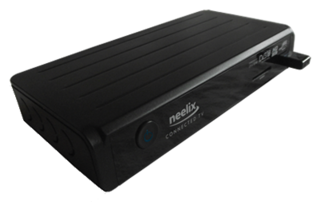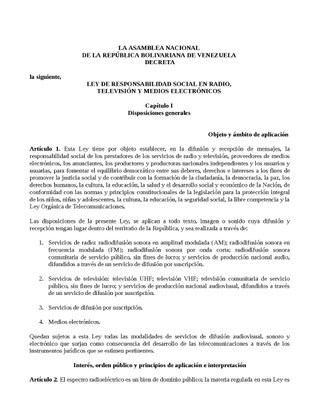
A set-top box (STB), also known as a cable box or receiver and historically television decoder or a converter, is an information appliance device that generally contains a TV-tuner input and displays output to a television set and an external source of signal, turning the source signal into content in a form that can then be displayed on the television screen or other display device. They are used in cable television, satellite television, and over-the-air television systems as well as other uses.

Children's television series are television programs designed specifically for children. They are typically characterised by easy-going content devoid of sensitive or adult themes and are normally broadcast during the morning and afternoon when children are awake, immediately before and after school schedules generally start in the country where they air. Educational themes are also prevalent, as well as the transmission of cautionary tales and narratives that teach problem-solving methods in some fashion or another, such as social disputes.
A motion picture content rating system classifies films based on their suitability for audiences due to their treatment of issues such as sex, violence, or substance abuse, their use of profanity, or other matters typically deemed unsuitable for children or adolescents. Most countries have some form of rating system that issues determinations variously known as certifications, classifications, certificates, or ratings. Age recommendations, of either an advisory or restrictive capacity, are often applied in lieu of censorship; in some jurisdictions movie theaters may have a legal obligation to enforce restrictive ratings.
A digital video recorder (DVR) is an electronic device that records video in a digital format to a disk drive, USB flash drive, SD memory card, SSD or other local or networked mass storage device. The term includes set-top boxes (STB) with direct to disk recording, portable media players and TV gateways with recording capability, and digital camcorders. Personal computers are often connected to video capture devices and used as DVRs; in such cases the application software used to record video is an integral part of the DVR. Many DVRs are classified as consumer electronic devices; such devices may alternatively be referred to as personal video recorders (PVRs), particularly in Canada. Similar small devices with built-in displays and SSD support may be used for professional film or video production, as these recorders often do not have the limitations that built-in recorders in cameras have, offering wider codec support, the removal of recording time limitations and higher bitrates.
In broadcasting, the watershed is the time of day after which programming with content deemed suitable only for mature or adult audiences is permitted. In the same way that a geological watershed divides two drainage basins, a broadcasting watershed serves as a dividing line in a schedule between family-friendly content, and content deemed suitable only for a more mature audience, such as programs containing objectionable content; this can include graphic violence, strong language, and sexual content, or strong references to those themes, even if they are not shown explicitly. The transition to more adult material must not be unduly abrupt and the strongest material should appear later in the evening.
Television content rating systems are systems for evaluating the content and reporting the suitability of television programmes for minors. Many countries have their own television rating system and countries' rating processes vary by local priorities. Programmes are rated by the organization that manages the system, the broadcaster, or the content producers.
The Parents Television and Media Council (PTMC), formerly the Parents Television Council (PTC), is an American media advocacy group founded by conservative Christian activist L. Brent Bozell III in 1995, which advocates for what it considers to be responsible, family-friendly content across all media platforms, and for advertisers to be held accountable for the content of television programs that they sponsor. The PTMC officially describes itself as a non-partisan organization, although the group has also been described as partisan and socially conservative.

Parental controls are features which may be included in digital television services, computers and video games, mobile devices and software that allow parents to restrict the access of content to their children. These controls were created to assist parents in their ability to restrict certain content viewable by their children. This may be content they deem inappropriate for their age, maturity level or feel is aimed more at an adult audience. Parental controls fall into roughly four categories: content filters, which limit access to age inappropriate content; usage controls, which constrain the usage of these devices such as placing time-limits on usage or forbidding certain types of usage; computer usage management tools, which enforces the use of certain software; and monitoring, which can track location and activity when using the devices.
The TV Parental Guidelines are a television content rating system in the United States that was first proposed on December 19, 1996, by the United States Congress, the American television industry, and the Federal Communications Commission (FCC). The guidelines went into effect by January 1, 1997, on most major broadcast and cable networks in response to public concerns about increasing amounts of mature content in television programs. It was established as a voluntary-participation system, with ratings to be determined by the individual participating broadcast and cable networks.
The Family Viewing Hour was a policy established by the Federal Communications Commission (FCC) in the United States in 1975. Under the policy, each television network in the U.S. bore a responsibility to air "family-friendly" programming during the first hour of the prime-time lineup. The policy was abandoned in 1977 following a 1976 ruling by a federal court that found it violative of the First Amendment. However, the concept has continued on a voluntary basis in various manifestations.

The American adult animated sitcom Family Guy has been the target of numerous taste and indecency complaints. The show is known to include offensive jokes including racial humor and violent, gory, and disturbing images.

The Movie and Television Review and Classification Board is a Philippine government agency under the Office of the President of the Philippines that is responsible for the classification and review of television programs, motion pictures and home videos.
Cable television first became available in the United States in 1948. By 1989, 53 million U.S. households received cable television subscriptions, with 60 percent of all U.S. households doing so in 1992. Most cable viewers in the U.S. reside in the suburbs and tend to be middle class; cable television is less common in low income, urban, and rural areas.

The Law on Social Responsibility on Radio and Television is a Venezuelan law adopted by the National Assembly and enforced since 7 December 2004. Its purpose was to establish a legal protocol for the ‘social responsibility’ of radio and television producers, broadcasters, viewers and listeners—both public/national and independent—in the dissemination and reception of transmitted media.
Television Watch is an American non-profit, non-partisan organization based in Charleston, South Carolina. The organization was established in May 2005 in response to the perceived increase in government regulation of television content. As an alternative to increased government control of the public airwaves, Television Watch promotes parental responsibility as the right way to protect children from inappropriate content on television.
The Family and Consumer Choice Act of 2007 is a proposed bill introduced by United States Representatives Daniel Lipinski (D-IL-3) and Jeff Fortenberry (R-NE-1) intending to allow families to choose and pay for only the cable TV television channels that they want to watch so that it will be easier to prevent their children from cable content they consider indecent. In addition, the bill would impose the same decency standards already in place on broadcast television onto cable channels, as between the hours of 6:00 a.m. and 10:00 p.m. in the Eastern and Pacific time zones, any indecent type of program, including programs rated "TV-14" or "TV-MA" under the TV Parental Guidelines, may not be broadcast. Lipinski has stated that it will provide parents, who are "the first line of defense in protecting their kids... more help". Currently, all cable television operators in the United States provide their channels in packages without offering packages containing only educational, news, family, or sports channels.
The Australian Commercial Television Industry Code of Practice is a self-regulatory code adopted by free-to-air broadcasters in the Australian media. Although developed by industry, the code has been registered with the Australian Communications and Media Authority (ACMA).
The United States pay television content advisory system is a television content rating system developed cooperatively by the American pay television industry; it first went into effect on March 1, 1994, on cable-originated premium channels owned by the system's principal developers, Home Box Office, Inc. and Showtime Networks. The voluntary-participation system—developed to address public concerns about explicit sexual content, graphic violence and strong profanity that tend to be featured in pay-cable and pay-per-view programming—provides guidance to subscribers on the suitability of a program for certain audiences based on its content.
Cartoon violence is the representation of violent actions involving animated characters and situations. This may include violence where a character is unharmed after the action has been inflicted. Animated violence is sometimes partitioned into comedic and non-comedic cartoon violence. Popular television programs with cartoon violence include Rick and Morty, Tom and Jerry, Looney Tunes, The Simpsons, and Family Guy.
The broadcast of educational children's programming by terrestrial television stations in the United States is mandated by the Federal Communications Commission (FCC), under regulations colloquially referred to as the Children's Television Act (CTA), the E/I rules, or the Kid Vid rules. Since 1997, all full-power and Class A low-power broadcast television stations have been required to broadcast at least three hours per-week of programs that are specifically designed to meet the educational and informative (E/I) needs of children aged 16 and younger. There are also regulations on advertising in broadcast and cable television programming targeting children 12 and younger, including limits on ad time, and prohibiting the airing of advertising for products related to the program currently airing.






